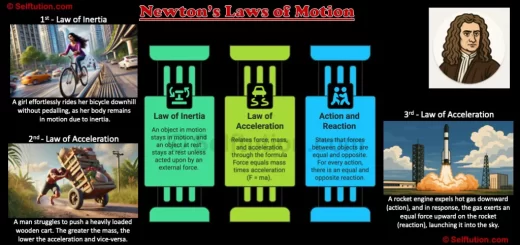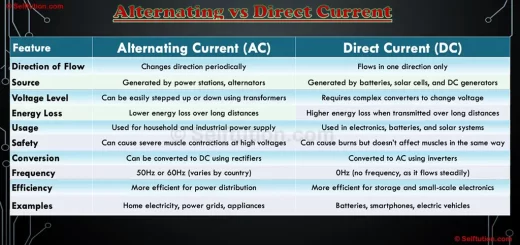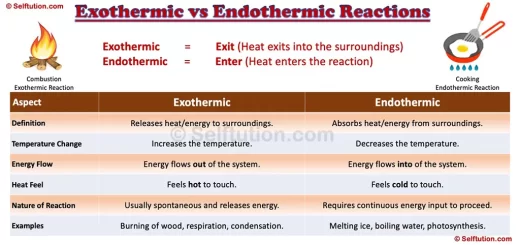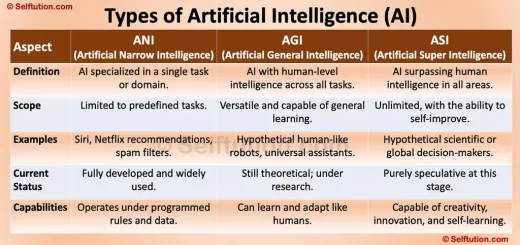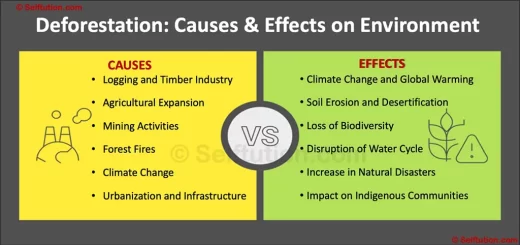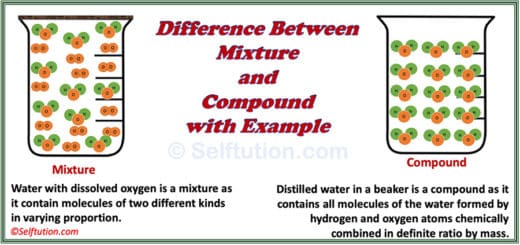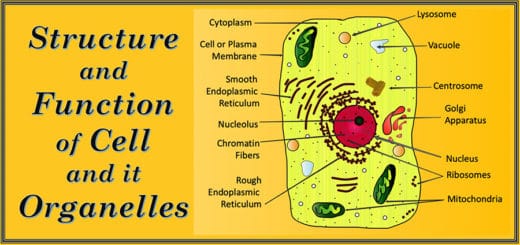Newton’s Laws of Motion Made Easy: A Student’s Guide
Have you ever wondered why a ball rolls to a stop instead of moving forever? Or why do you feel pushed back into your seat when a car accelerates? The answers lie in Newton’s Laws of Motion.
Newton’s Laws of Motion – three fundamental principles explain how objects move and interact with forces.
At first glance, Newton’s Laws of Motion might seem intimidating, but they’re quite intuitive once broken down.
Whether you’re a student struggling with physics homework or just curious about how the world works, this guide will make Newton’s Laws of Motion simple, relatable, and even a little fun.
Let’s dive in.
Topic Covered:
- Newton’s First Law of Motion: The Law of Inertia
- Newton’s Second Law of Motion: The Force-Acceleration Relationship
- Newton’s Third Law of Motion: Action and Reaction
- Putting Newton’s Laws of Motion Together
- Common Questions about Newton’s Laws of Motion
Newton’s First, Second & Third Laws of Motion
Newton’s First Law of Motion: The Law of Inertia
An object in motion stays in motion, and an object at rest stays at rest unless acted upon by an external force.
This fundamental principle, known as the Law of Inertia, is the first of Newton’s Laws of Motion and describes how objects naturally resist changes in their state of motion. Inertia isn’t just a physics term—it’s something we experience daily, often without realizing it.
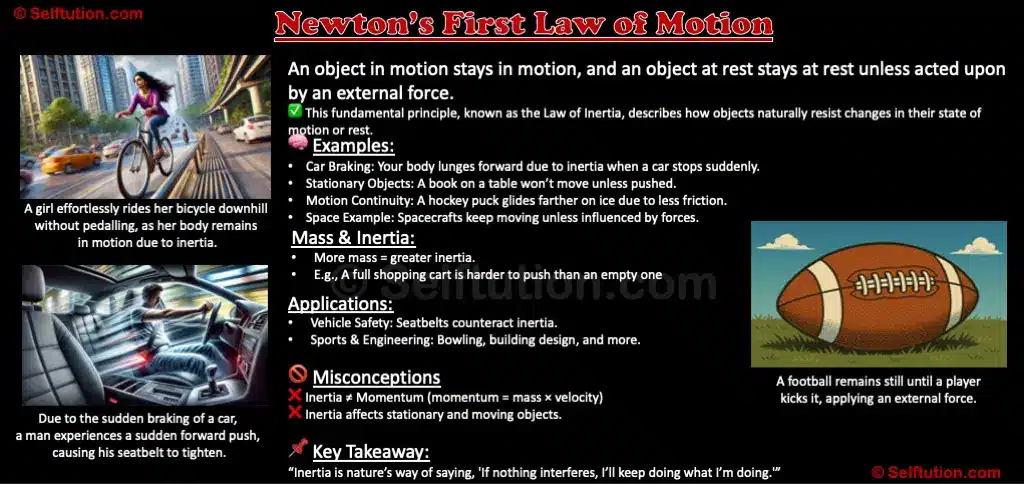
Newton’s First Law of Motion or Law of Inertia
Understanding Inertia in Everyday Life
Let’s break it down with relatable examples:
- Sudden Brakes in a Car:
- When a moving car stops abruptly, your body jerks forward. Why? Because your body wants to keep moving at the car’s original speed. The seatbelt provides the external force that stops you, just as Newton’s First Law of Motion predicts.
- Without a seatbelt, inertia would keep you moving forward until another force (like the dashboard or windshield) stops you, often painfully.
- Objects at Rest:
- A book lying on a table won’t suddenly slide off unless something pushes it, like your hand or a gust of wind.
- A soccer ball remains still until a player kicks it, applying an external force.
- Objects in Motion:
- A hockey puck glides farther on smooth ice than on rough carpet because friction (an external force) is weaker on ice.
- In space, where there’s minimal friction, a spacecraft can coast indefinitely without thrust until gravity or another force alters its path.
Why Mass Matters in Inertia
Inertia isn’t just about motion—it’s also tied to mass. The more mass an object has, the more it resists changes in movement.
- Example: Pushing an empty shopping cart is easy, but pushing one loaded with groceries requires more effort because the heavier cart has greater inertia.
- Fun Fact: This is why sumo wrestlers are hard to move—their high mass gives them tremendous inertia!
Real-World Applications of the First Law
- Vehicle Safety: Seatbelts and airbags work because of inertia—they counteract your body’s tendency to keep moving during a collision.
- Sports: Inertia explains why a bowling ball doesn’t stop instantly after hitting the pins—it gradually slows due to friction.
- Engineering: Buildings are designed to resist inertia during earthquakes, preventing collapse when the ground shakes.
Common Misconceptions About Inertia
- “Inertia is the same as momentum.”
- No—momentum depends on both mass and velocity (p = mv), while inertia depends solely on mass.
- “Inertia only applies to moving objects.”
- False! It applies equally to stationary objects (like the book on the table).
Key Takeaway
Inertia is nature’s way of saying, “If nothing interferes, I’ll keep doing what I’m doing.” Whether it’s a rolling ball, a speeding car, or your own body, Newton’s First Law of Motion reminds us that objects resist change—until a force steps in.
Newton’s Second Law of Motion: The Force-Acceleration Relationship
Force equals mass times acceleration (F = ma).
This law, a cornerstone of Newton’s Laws of Motion, connects force, mass, and acceleration in a simple yet powerful equation. It tells us exactly how an object will respond when a force is applied—whether it’s a gentle nudge or a powerful shove.

Newton’s Second Law of Motion or the Law of Acceleration
Breaking It Down Further
Let’s examine each component of F = ma in detail:
- Force (F):
- A push or pull that can make an object start moving, stop moving, or change direction.
- Measured in Newtons (N)—where 1 Newton is roughly the force needed to accelerate a 1 kg object at 1 m/s².
- Forces can be contact forces (like kicking a ball) or non-contact forces (like gravity pulling you down).
- Mass (m):
- Not just “how much stuff” is in an object—it’s also a measure of inertia (resistance to acceleration).
- Measured in kilograms (kg).
- A key difference: Mass stays the same everywhere, but weight (which depends on gravity) can change.
- Acceleration (a):
- The rate at which an object’s velocity changes—whether speeding up, slowing down, or changing direction.
- Measured in meters per second squared (m/s²).
- Negative acceleration (deceleration) happens when a force acts opposite to the direction of motion (like brakes slowing a car).
Why This Equation Matters
Newton’s Second Law of Motion is like a universal rulebook for motion. It explains:
- Why does a light object (like a tennis ball) accelerate faster than a heavy object (like a bowling ball) when the same force is applied?
- Why a rocket needs enormous thrust (force) to lift off—it must overcome not just gravity but also its massive weight.
- Why seatbelts are crucial—during a sudden stop, your body’s inertia keeps it moving forward until an opposing force (the seatbelt) decelerates you safely.
More Real-World Examples
- Sports Science:
- A baseball pitcher accelerates the ball by applying force with their arm. The harder they throw (more force), the faster the ball travels (greater acceleration).
- Golfers use heavy clubs to transfer maximum force to the ball, but the ball’s low mass allows it to accelerate rapidly.
- Vehicle Dynamics:
- A sports car accelerates faster than a truck because it has less mass relative to its engine’s force output.
- Electric cars optimize instant torque (force) to achieve rapid acceleration from a standstill.
- Everyday Phenomena:
- Pushing a half-empty shopping cart vs. a fully loaded one—the latter requires more force to achieve the same acceleration.
- It’s harder to stop a bicycle moving downhill (greater speed = more deceleration force needed).
Common Misconceptions
- “Force causes velocity.”
- Force causes acceleration (change in velocity). An object can move at constant speed with zero net force (Newton’s First Law).
- “More mass always means slower acceleration.”
- True only if the force stays the same. A rocket’s engines compensate for huge mass by producing colossal force.
Key Takeaway
Newton’s Second Law of Motion is the reason why:
- Tiny pebbles skip easily across water (low mass, high acceleration).
- It takes a jet engine to lift a plane (a huge mass needs a huge force).
- You feel “heavier” in an elevator accelerating upward (extra force acting on you).
Next time you push something, think: “How much mass am I moving? How fast do I want it to go?” That’s F = ma in action!
Newton’s Third Law of Motion: Action and Reaction
For every action, there is an equal and opposite reaction.
This law, the final piece of Newton’s Laws of Motion, is all about pairs of forces—every interaction involves two forces acting on two different objects.
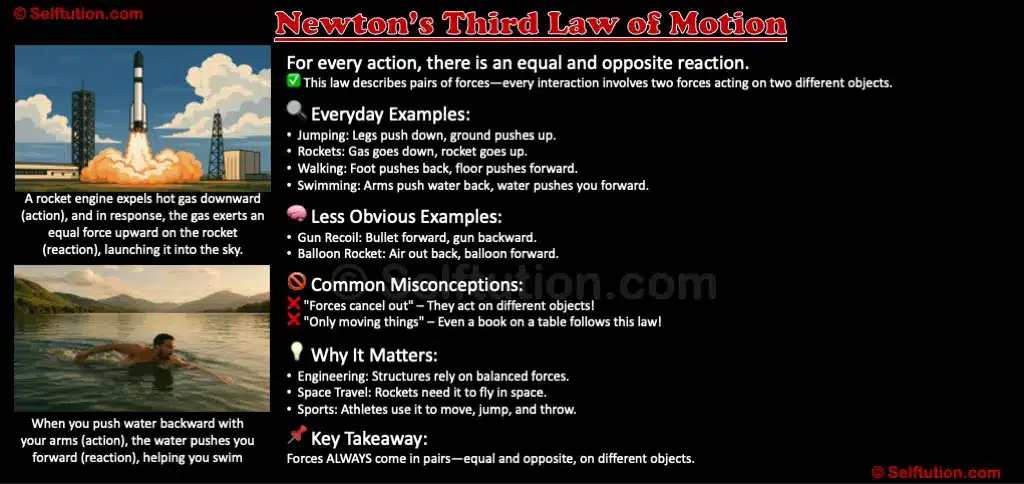
Newton’s Third Law of Motion, or the Law of Action and Reaction
What Does This Look Like?
Everyday Examples:
- Jumping: When you jump, your legs exert a downward force on the ground (action). Simultaneously, the ground pushes you upward with an equal force (reaction), propelling you into the air.
- Rockets in Space: A rocket engine expels hot gas downward (action), and in response, the gas exerts an equal force upward on the rocket (reaction), launching it into the sky.
- Walking: Your foot pushes backward against the floor (action), and the floor pushes you forward (reaction), allowing you to move.
- Swimming: When you push water backward with your arms (action), the water pushes you forward (reaction), helping you glide through the pool.
Less Obvious (But Equally Important) Examples:
- Gun Recoil: When a bullet is fired, the gun exerts a forward force on the bullet (action), and the bullet exerts an equal backward force on the gun (reaction), causing the “kickback” you feel.
- Balloon Rocket Experiment: If you release an inflated balloon without tying it, the air rushes out backward (action), and the balloon shoots forward (reaction).
Common Misconceptions
Myth: “Action and reaction forces cancel each other out.”
- Reality: The forces are equal and opposite, but they act on different objects, so they don’t cancel out.
- Example: When you push a heavy box, the box pushes back on you with the same force. If the box doesn’t move, it’s because friction opposes your push, not because the forces “cancel.”
Myth: “Only moving objects follow Newton’s Third Law.”
- Reality: Even stationary objects obey this law!
- Example: A book resting on a table pushes down (action), and the table pushes up (reaction) with equal force. If the table didn’t push back, the book would fall through!
Why Is This Law So Important?
- Engineering: Bridges, buildings, and machines rely on balanced action-reaction forces to stay stable.
- Space Travel: Rockets wouldn’t work without this law—there’s no air in space to push against, so they depend on expelling gas for thrust.
- Sports: Athletes use reaction forces to their advantage—sprinters push against starting blocks, and basketball players push off the ground to jump higher.
Key Takeaway:
Forces always come in pairs. Whenever one object exerts a force on another, the second object exerts an equal and opposite force right back. This isn’t just a physics rule—it’s how the universe works!
Putting Newton’s Laws of Motion Together
Let’s see how these laws work in a single scenario: driving a car.
- First Law (Inertia): When the car stops suddenly, your body keeps moving forward until the seatbelt applies a force to stop you.
- Second Law (F=ma): Pressing the gas pedal increases the engine’s force, making the car accelerate. A fully loaded car (more mass) accelerates more slowly than an empty one.
- Third Law (Action-Reaction): The tires push backward on the road, and the road pushes the car forward.
See how neatly Newton’s Laws of Motion fit together?
Common Questions About Newton’s Laws of Motion
1. Do Newton’s Laws of Motion apply in space?
Absolutely! They’re easier to see in space because there’s no friction or air resistance. A spacecraft will keep moving forever unless a force acts on it (First Law).
2. Why don’t action-reaction forces cancel out?
Because they act on different objects. If you push a box, the box pushes back on you, but only the box moves because the forces aren’t on the same thing.
3. How is mass different from weight in Newton’s Laws of Motion?
Mass is how much matter is in an object (constant everywhere). Weight is the force of gravity acting on that mass (changes on different planets).
Final Thoughts on Newton’s Laws of Motion
Newton’s Laws of Motion aren’t just abstract physics concepts—they’re part of everyday life. From walking to driving to playing sports, these principles govern how objects move and interact.
The next time you see a ball rolling to a stop or feel yourself pushed back in a rollercoaster, remember: Newton figured this out 300 years ago, and now you understand them, too.
If you found this guide helpful, why not try observing Newton’s Laws of Motion in action? You’ll start seeing physics everywhere—and that’s when learning truly becomes exciting.
You may also like…... Types of Chemical Reactions in Chemistry

